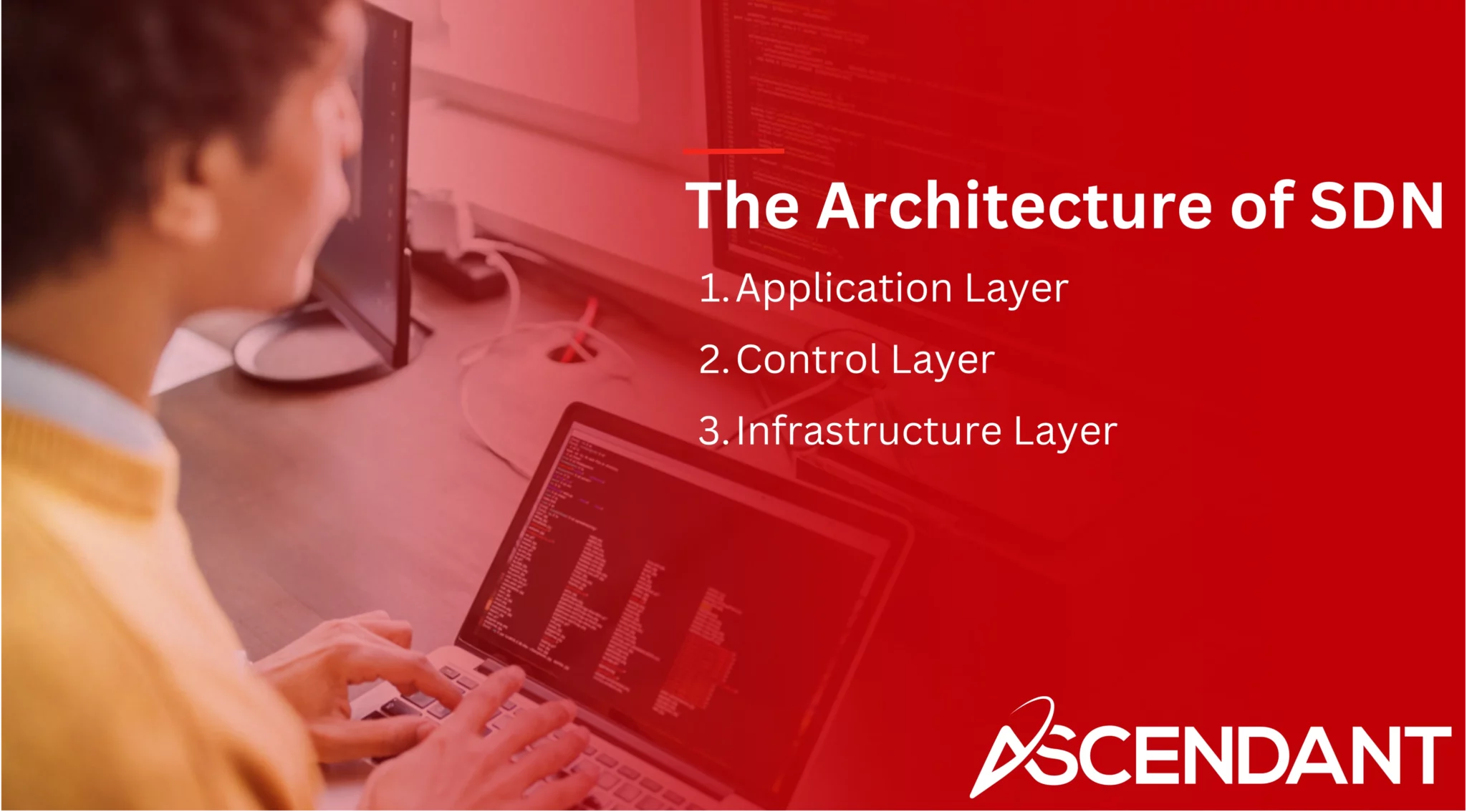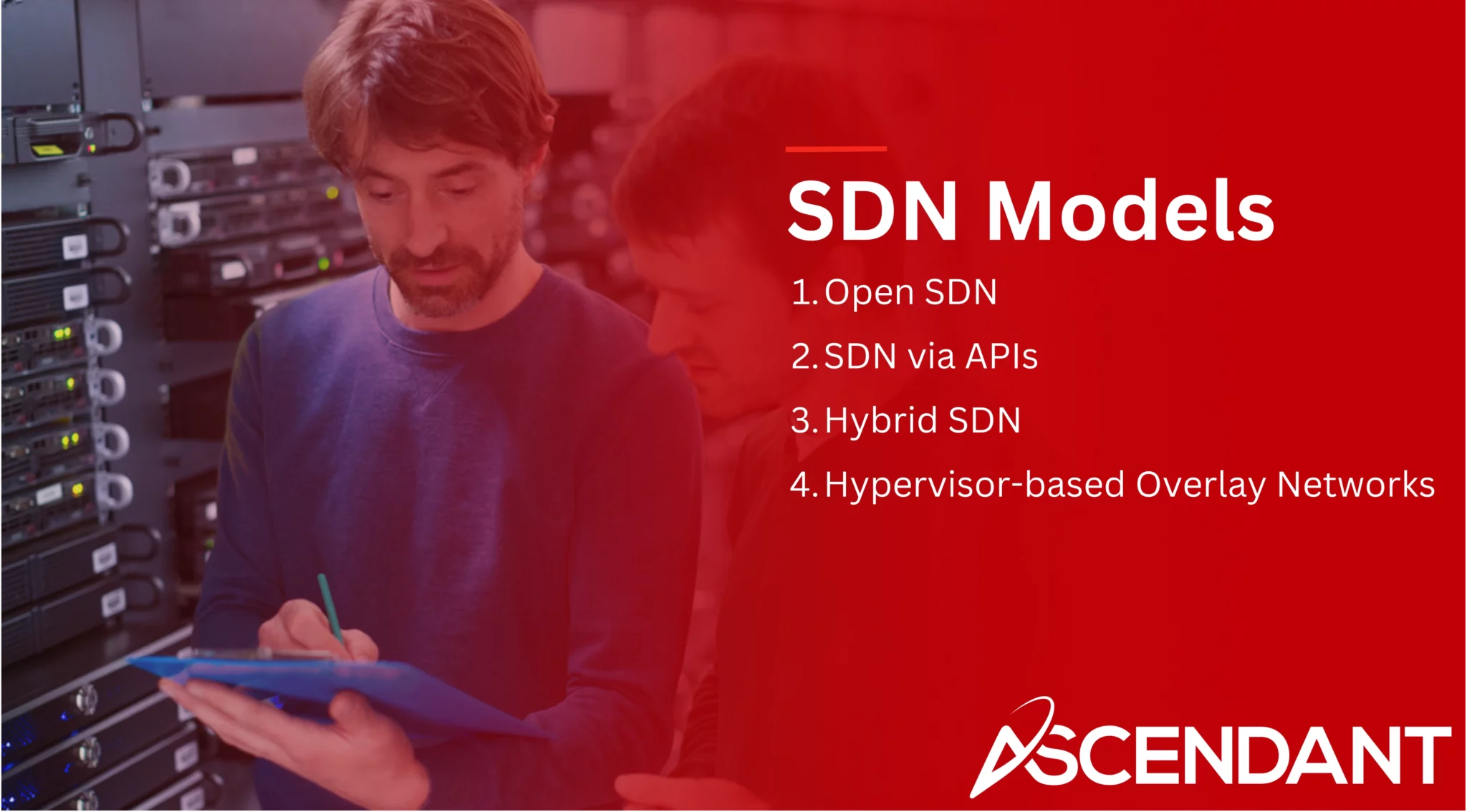Software defined networking (SDN) is a way to manage networks that separates control from hardware. This means you can control the entire network from a central point, making management easier and more flexible. In this article, you’ll learn what SDN is, how it works, and why it’s important for modern networks.
Key Takeaways
- Software Defined Networking (SDN) separates the control plane from the data plane, allowing for centralized management and enhanced flexibility in network operations.
- The SDN architecture comprises three layers: application, control, and infrastructure, each responsible for distinct roles that facilitate efficient data flow and resource management.
- Despite its benefits, SDN faces challenges such as potential cybersecurity vulnerabilities and integration complexities during implementation, necessitating careful consideration by organizations.
Defining Software Defined Networking (SDN)
The essence of Software Defined Networking (SDN) lies in its revolutionary approach to handling network infrastructure, which achieves a separation between the control logic and the hardware. In contrast to conventional networking systems where both control and data planes are conjoined within the networking devices, SDN delineates these components to augment manageability and agility. The result is an arrangement that enables centralized oversight over network resources, thus creating a more malleable software-defined framework for networks.
In an SDN setup, there exists a centrally located control plane governed by sophisticated software algorithms responsible for orchestrating operations across the data plane — the segment tasked with actual data packet transport on the network’s data plane layer — ensuring seamless navigation of information packets throughout this ecosystem. This design grants meticulous manipulation capabilities alongside rapid adaptation potential concerning network traffic flows. Traits that have positioned SDNs as integral assets in contemporary strategies pertaining to management of networks. Through programmatically directed controllers or APIs applied over physical device layers, such precision brings forth marked strides in resource utilization effectiveness.
Within standard models of SDNs, can be discerned three fundamental tiers:
- Application Layer: Occupying this level are diverse applications delivering requisite services tied directly into user needs.
- Control Layer: A pivotal stratum charged with deliberation upon optimal pathways for channeling datasets through interconnected nodes.
- Infrastructure Layer: Here reside tangible constituents forming foundational backbones like routers or switch modules involved inherently in shaping up networks.
This trio-layer architecture not only streamlines administration procedures but also propels advancements regarding overall throughput rates achieved via granting system overseers singular convergence points from which commanding directives might issue consistently across all operational touchpoints within said frameworks.
The Architecture of SDN
The structure of SDN is carefully crafted to optimize network operations by dividing the network into three separate layers: application, control, and infrastructure. By doing so, it creates a separation that assigns specific areas of focus for each layer related to managing and operating the network.
Inter-layer communications are managed through designated APIs. With southbound APIs governing communication between the control and infrastructure layers, while northbound APIs regulate interactions between the control layer and applications. This enables an efficient exchange of information across different levels of the system.
Application Layer
In an SDN architecture, the application layer functions as the network’s intellect, encompassing a range of network applications and capabilities including intrusion detection systems, load balancing, and firewalls. Previously requiring dedicated hardware appliances for each function, these applications are now governed by a singular central controller that streamlines the complexity of network infrastructure.
The relationship between this topmost layer and the control layer is facilitated through northbound interfaces which Utilize RESTful APIs to enable communication. This setup permits agile modifications and immediate management of network resources in order to tailor network behavior to suit the demands of various applications and services precisely.
Control Layer
The SDN controller, which resides at the heart of the control layer, embodies the central brain within an SDN architecture and is tasked with orchestrating traffic flow and implementing network-wide policies. Positioned on a dedicated server, this controller functions as a pivotal hub that allocates paths for application data transit while steering traffic in adherence to established rules.
Integral to its operation, the control layer possesses the capability to dynamically dictate operational parameters for routers and switches by issuing instantaneous directives down to the infrastructure layer. This coordination ensures judicious allocation of network resources while augmenting overall efficiency and optimizing management of network assets under centralized command.
To enable seamless communication between these two tiers—the decision-making authority of control plane and execution realm of forwarding plane—the OpenFlow protocol plays an indispensable role.
Infrastructure Layer
The foundational component of the SDN architecture, known as the infrastructure layer, includes a variety of network devices that carry out actions based on directives received from the control layer. This assortment encompasses routers and switches tasked with analyzing and directing data packets toward their intended targets.
By adhering to guidance provided by the control layer for traffic routing, this infrastructure level enhances resource use while improving overall network performance. The capacity of this particular tier to modify traffic routes dynamically in real-time stands as an essential aspect contributing to the superior efficiency and flexibility characteristic of Software-Defined Networking (SDN).
How SDN Works
In SDN, the essence lies in the clear distinction between the data plane and control plane, marking a significant departure from traditional networking paradigms. Within this model, switches receive directives on packet handling and routing from a centralized controller—a stark contrast to past methodologies—enabling more dynamic and responsive network management capabilities. This setup permits switches to engage with the controller for guidance when encountering packets that lack predefined routes.
APIs are crucial within SDN as they empower manipulation of data flows across various network devices without being restricted only to established standards. Such an arrangement grants network administrators considerable leeway in crafting tailored network policies that can be modified swiftly, ensuring that networks operate harmoniously with specific enterprise objectives and requirements.
Key Benefits of SDN
SDN provides a host of advantages that render it an appealing choice for contemporary network management. Foremost among these is the increased agility within the network infrastructure, as administrators can govern data flow through a solitary software interface. This programmability affords the ability to enact tailored network strategies quickly responding to evolving organizational demands.
Through its centralized control feature, SDN offers dynamic adjustment and enhancement of network resources, thereby elevating both performance levels and scalability potential. With SDN’s facility for network virtualization comes an abstracted networking model which eases traffic handling and resource distribution when contrasted with traditional networks’ tangible limitations while still ensuring efficient programmatic configuration of the said networks.
Augmenting SDN’s appeal is its cost-effectiveness: by severing hardware from network management tasks, there’s less necessity for extraneous physical devices, allowing enterprises to expand their networking capabilities using software options instead. Consequently, this diminishes reliance on material equipment yielding reduced operational expenditures alongside a more refined construction of the existing network setup.
Challenges and Considerations
SDN offers a multitude of benefits. It also comes with several challenges that must be taken into account. A notable concern is the susceptibility of the centralized control plane to cybersecurity risks, which, if compromised, could leave the SDN controller open to attacks such as denial-of-service (DoS), potentially disrupting network functionality and administration.
Moving towards an SDN framework can prove complex due to necessary updates in hardware and modifications in configurations. The lack of uniform protocols specific to SDNs complicates matters by creating hurdles when trying to combine elements from various manufacturers.
Organizations looking at adopting SDN technology should carefully deliberate these aspects for a seamless and secure integration within their networks.
Common Use Cases for SDN
The flexibility of SDN renders it appropriate for numerous applications. Automating testing and deploying updates are typical uses that refine network management practices and boost productivity. Within campus settings, SDN eases the complexity of networking by providing centralized oversight for both WiFi and Ethernet connections.
Traffic engineering also greatly benefits from SDN’s capabilities, as it permits the centralization of command over data pathways to improve network efficiency. With In-Band Network Telemetry (INT), telemetry directives are incorporated directly into packet headers, thus strengthening security and surveillance functions while delivering more profound analysis regarding network behavior.
Comparing SDN with Traditional Networking
SDN distinguishes itself from traditional networking practices by concentrating the network’s intelligence and decoupling the data planes from a central control plane. In conventional networks, both control and data planes are conjoined within networking devices, which creates more complexity in management and lessens flexibility. SDN contrasts this with its software-driven approach to manage network resources centrally, enhancing flexibility and governance.
Open APIs facilitate communication within SDN frameworks, providing a stark contrast to the proprietary protocols commonplace in traditional networks. This open nature of SDNs not only simplifies integration and programming, but also enhances cost efficiency by allowing for sustained network uptime without reliance on additional hardware investments.
SDN Controllers
Acting as a centralized management nexus within SDN architecture, SDN controllers play an essential role in controlling network flows. They centralize the control function, thereby minimizing manual interventions on separate network devices by managing traffic according to predefined forwarding rules. This aggregation of control streamlines operations and makes network management more straightforward.
SDN controllers enable dynamic adjustment of traffic by offering a comprehensive perspective of the entire network infrastructure. They alert administrators about potential bottlenecks or irregularities. By mediating between applications and various network devices via northbound and southbound interfaces, these controllers promote unified and effective administration across the network ecosystem.
SDN Models
Each SDN model presents unique methods for controlling and managing networks, with the main models being Open SDN, API-driven SDN, hybrid approaches, and hypervisor-based overlays. These varying techniques are utilized to enhance network adaptability and optimize performance within each distinct framework of network management.
Open SDN
The Open SDN model employs OpenFlow-compatible switches for an efficient setup, allowing network data streams to be managed centrally via a southbound API. This communication between the controllers and the switches is made possible by utilizing the OpenFlow protocol.
SDN via APIs
Through APIs like SNMP, CLI, or Rest API in SDN environments, network devices can be controlled and managed efficiently. The controller utilizes these interfaces to remotely operate the devices, enabling flexible management of the network.
Hybrid SDN
The integration of classic networking methodologies with those of software-defined networking (SDN) is at the core of Hybrid SDN, yielding a network milieu that boasts improved adaptability and flexibility. By fusing standard network operations with those governed by software, this paradigm excels in boosting both resource efficiency and overall performance.
Employing a hybrid strategy ensures that diverse networking demands can be met effectively, positioning it as an exemplary choice for entities aiming to harness the advantages intrinsic to both traditional and software-defined networking paradigms.
Hypervisor-based Overlay Networks
Overlay networks based on hypervisors establish a virtual network atop the pre-existing physical infrastructure without altering the configuration of physical devices. This method enhances security and isolation by hiding details about other devices within the physical network.
Independently functioning from the base physical network, these overlay networks facilitate more adaptable and proficient management throughout the entire network. Such an arrangement is especially advantageous in settings that utilize virtual machines and virtual network functions, streamlining both configuration and oversight of various network functions.
The Impact of SDN on Modern Networking
SDN revolutionizes contemporary networking through its ability to provide centralized management and policy implementation over widespread networks. Within cloud settings, SDN simplifies the establishment of virtual networks which automate the provisioning of resources, thereby increasing both efficiency and flexibility.
By promoting effective data transmission paths and reducing latency in communications, this technology is essential for the proliferation of IoT as well as edge computing initiatives. With a burgeoning SD-WAN market, the importance of SDN in upgrading network functionality and administration continues to rise.
SDN and Network Functions Virtualization (NFV)
NFV and SDN collaborate closely to improve network adaptability and performance. NFV decouples network functions from physical devices, leading to more flexible network services. By combining SDN with NFV, centralized management of the infrastructure is achieved along with virtualization benefits, which minimizes reliance on hardware and accelerates the rollout of new services.
The fusion of SDN into NFV offers enterprises enhanced capabilities in administering, running, and safeguarding their networks while simultaneously enabling faster service provision with reduced dependence on physical hardware.
SDN and SD-WAN
Utilizing the fundamentals of Software-Defined Networking (SDN), SD-WAN technology transforms the management of wide-area networks, enhancing and simplifying connectivity through streamlined configuration. By generating a virtual overlay that separates underlying links within a WAN, SD-WAN effectively allocates network traffic over multiple pathways to guarantee superior performance and dependability.
With an emphasis on linking various geographic sites, SD-WAN boosts consistent delivery of network services. This method bolsters network performance by intelligently choosing optimal routes for data transit. It also strengthens security with comprehensive encryption from one endpoint to another while providing centralized management tools that simplify oversight and tracking operations.
Summary
SDN ushers in a new era of network management by centralizing authority, augmenting adaptability, and bolstering efficiency. By disentangling the control plane from the data plane, SDN enables networks to be dynamic and programmable, providing an invaluable resource for today’s network administrators. The structuring into application, control, and infrastructure strata ensures that operations are conducted smoothly and proficiently.
Despite facing hurdles such as security vulnerabilities and intricate integration processes, the advantages of SDN – like cost savings, expandability, and performance enhancement – present it as an attractive solution for entities seeking to upgrade their network infrastructure. As advancements in SDN press forward, the significance it holds for contemporary networking is poised to amplify, promoting progressiveness and operational effectiveness within the sphere of digital technology.
Frequently Asked Questions
What is Software Defined Networking (SDN)?
Software Defined Networking (SDN) represents an approach to network management that separates the control of software from the underlying hardware. This separation facilitates centralized management, which in turn provides improved flexibility when allocating network resources.
The decoupling inherent in SDNs significantly increases the capacity for effective adaptation and optimization of network performance.
How does SDN differ from traditional networking?
SDN distinguishes itself from conventional networking by separating control and data planes. This separation allows for centralized administration, which improves the ability to manage network traffic with greater flexibility and adaptability, thereby responding more efficiently to changing network requirements.
What are the main benefits of using SDN?
The main benefits of using Software-Defined Networking (SDN) include enhanced network flexibility, cost-efficiency, improved performance, and simplified network management through centralized control and dynamic configuration.
These advantages make SDN a compelling choice for organizations seeking to optimize their network infrastructure.
What challenges should organizations consider when implementing SDN?
Organizations should consider potential security vulnerabilities of the centralized control plane, the complexity of transitioning from traditional networks, and integration difficulties arising from the lack of standardized SDN protocols.
Addressing these challenges is crucial for successful SDN implementation.
How do SDN and SD-WAN work together?
SD-WAN applies the principles of SDN to effectively oversee and improve wide-area networks by creating a virtual overlay that simplifies link connectivity, which ensures network traffic is centrally managed for better performance and dependability.
Such a combination provides increased adaptability and agility within the realm of network management.




